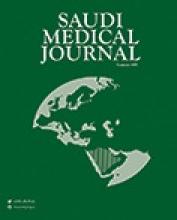Abstract
OBJECTIVE: Osteoporosis and osteopenia among postmenopausal Saudi Arabian women are common to the extent of over 60%. Pregnancy, multiparity and prolonged lactation are suggested as factors modifying negatively in the development of osteoporosis. Earlier reports from the institution indicated a beneficial role of multiparity in postmenopausal osteoporosis (PMO). We conducted this study to measure the effect of parity on bone mineral density (BMD) measurement of lumbar spine and the upper femur.
METHODS: We conducted this prospective study at King Fahd Hospital of the University, College of Medicine, King Faisal University, Dammam, Saudi Arabia, between January 2002 and June 2003. This study analyzed 256 patients who attended orthopedic clinics. The data gathered was age, duration of menopause, number of children borne, height and weight for body mass index (BMI) calculation. We excluded women with secondary osteoporosis from the study. We entered the patients orthopedic complaints in the database. We carried out the BMD measurements using Hologic total body DEXA machine. We analyzed the data using SPSS package with significance at p<0.05 and confidence interval of 95%. For final analysis, we took into consideration an average of results of the lumbar spine and hip region.
RESULTS: We analyzed the available data of 256 patients. We divided the patients into 2 groups; group A with >6 children and group B with women of <5 children. In group A, there were 116 women and 140 in group B. The mean age of patients in group A was 56.81 (50-65) years SD ± 5.19 and in group B the mean age was 58.86 years (48-76) SD ± 7.68. The average BMI in group A was 31.95 kg/m2 and in group B it was 29.14 kg/m2. The BMD of the lumbar spine of group A was 0.850g/cm2 (SD±0.112) compared to group B of 0.699g/cm2 (SD±0.141), p<0.005. The BMD of the hip region of group A was 0.836g/cm2 and that of group B patients was 0.716g/cm2 (p<0.01). In women with <5 children, 25.5 had normal BMD as compared to 47 in women with >6 children, 25.4% were osteoporotic in group A and in group B 48%. As per the World Health Organization classification 56% in group A had an increased risk of fracture as compared to 77.5% in group B women.
CONCLUSION: Our results indicate that women who had borne >6 children were less osteoporotic and of low fracture risk as compared to those women who had <5 children. The BMD of the women with >6 children was statistically higher than their counterparts, and they sustain this after prolonged lactation. We believe that increased parity protects women from osteoporosis and the severity of the disease, and it is our suggestion that women with <5 children and those nulliparous, who are at increased risk of developing osteoporosis should be investigated and treated accordingly.
- Copyright: © Saudi Medical Journal
This is an open-access article distributed under the terms of the Creative Commons Attribution-Noncommercial-Share Alike 3.0 Unported, which permits unrestricted use, distribution, and reproduction in any medium, provided the original work is properly cited.






